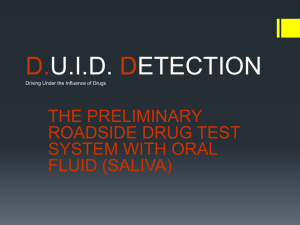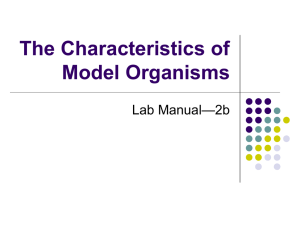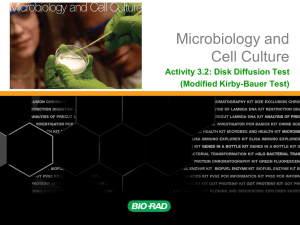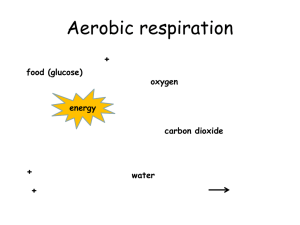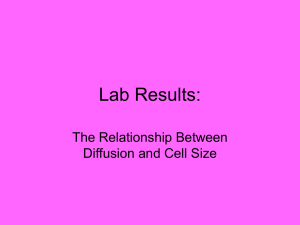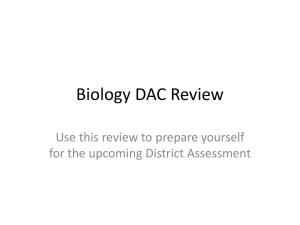Presentation - Wisconsin State Laboratory of Hygiene
advertisement
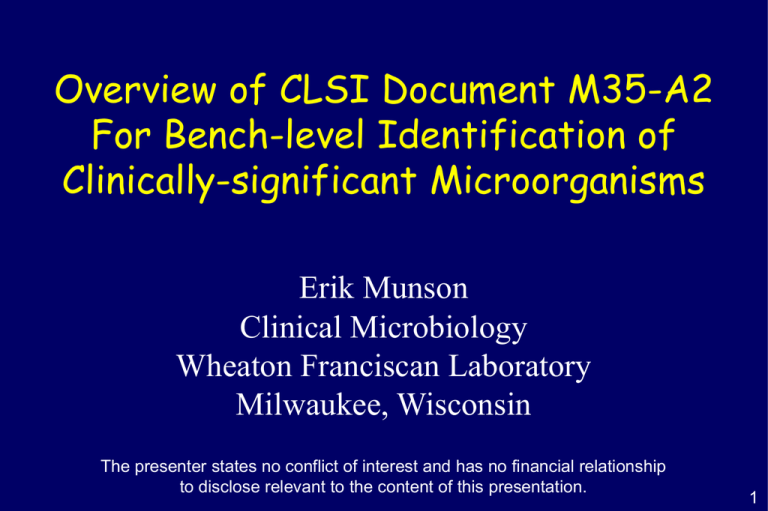
Overview of CLSI Document M35-A2 For Bench-level Identification of Clinically-significant Microorganisms Erik Munson Clinical Microbiology Wheaton Franciscan Laboratory Milwaukee, Wisconsin The presenter states no conflict of interest and has no financial relationship to disclose relevant to the content of this presentation. 1 OUTLINE I. Introduction of concept II. Major players III. Application one A. B. CLSI M35-A2 Perhaps why you are here IV. Application two A. B. Routine (but possibly covert) bench dealings Help out WSLH 2 Introduction 3 INTRODUCTION TO CLSI M35-A2 Goes way back to the introduction of commercial identification systems Laboratories lacking confidence, resources in validation of alternative methods Utilization of these methods has resulted in greater standardization and more accuracy In some cases, may have resulted in cost and turnaround time increases 4 INTRODUCTION TO CLSI M35-A2 Laboratorians have used rapidly-determined characteristics for years; this document seeks to standardize this Odor Immediate enzymatic reactions (spot testing) Cost savings associated with using rapid methods or overall patient care benefits Chromogenic medium Agglutination Macroscopic, microscopic Slide Spot Disk Fluorogenic Enzymatic Single-tube 5 BENEFITS OF RAPID RESULTS Turnaround Length of Mortality Time P Stay P 4 Index P 4 Study Average Cost P 4 Notes Doern et al.1 < 0.0005 NS5 < 0.02 0.01 Rapid MicroScan product Barenfanger et al. 2 0.0014 0.006 0.45 0.04 VITEK product Kerremans et al. 3 < 0.0001 ND6 0.21 ND VITEK products 1J. Clin. Microbiol. 32: 1757-1762; 1994 2J. Clin. Microbiol. 37: 1415-1418; 1999 3J. Antimicrob. Chemother. 61: 428-435; 2008 4Role of rapid susceptibility testing also factored into this calculation 5Not significant 6Not determined 6 WARNING Laboratory directors, managers, and supervisors responsible for ensuring appropriate use of rapid methods “Isolates to be tested should match the criteria required for proper identification.” CLSI M35-A2; 2008 Competency assessment Colony, Gram stain Smell (when safe) 7 CAVEATS Isolates conforming to reactions described in M35-A2 identify organism with >95% accuracy; identification can be reported without qualification “Confirmation by additional procedures is unnecessary for many of the species described in this document.” CLSI M35-A2; 2008 Lack of a positive result does not rule out the identification of an isolate; just signifies need for additional testing 8 MORE WARNINGS Employ standard precautions Cover transmission of all infectious agents Universal precautions cover blood-borne pathogens Refer to CLSI M29 Sniffing/wafting can be dangerous Once mold colony is ruled out, opening of plates from non-invasive sources (i.e., urine, sputum) is common & relatively safe P. aeruginosa, H. influenzae, Eikenella, S. anginosus group odor can be detected by opened plates “not sniffed purposely” 9 EXCLUSIONS???? Rapid results may need to be validated Certain microbes from normally-sterile sites Potential agents of bioterrorism Microbes important to infection control practitioners Microbes implicated in nosocomial outbreaks Risk (being wrong) vs. benefit (patient care/safety) M35-A eliminated certain organism groupings However, possibility of serious pathogen or ability to rule out potential agent of bioterrorism has resulted in M35-A2 including additional organisms 10 Major Players 11 CLSI M35-A2 PROTOCOLS Test descriptions Principle Reagents Procedure Interpretation Limitations (precautions) Quality control Thirteen reagents/tests Bile solubility Rapid spot CAMP Catalase (aerobes) Catalase (anaerobes) Germ tube Rapid hippurate hydrolysis Spot indole Indoxyl acetate MUG test Spot oxidase d-aminolevulinic acid Rapid trehalose Urea/phenylalanine deaminase 12 CATALASE 3% hydrogen peroxide Touch center of isolated colony with stick Transfer to clean glass slide Place drop of hydrogen peroxide onto cell paste “Immediate” bubbling (< 20 seconds) is positive No non-platinum loops; don’t grab blood agar If slow-growing isolate on blood agar (no growth MacConkey) or small GNR, perform test in biological safety cabinet 13 SPOT INDOLE 5% (w/v) p-dimethylaminobenzaldehyde 1% paradimethylaminocinnamaldehyde in HCl Moisten piece of filter paper with reagent Rub portion of CFU from blood agar onto paper Growth medium must contain sufficient tryptophan Pigment formation (< 20 seconds) is positive Cannot use media containing dyes Cannot use Mueller-Hinton or high-glucose agar Detectable indole diffuses to adjacent colonies within 5 mm (false-positive results) 14 SPOT OXIDASE 1% tetramethyl-p-phenylenediamine dihydrochloride Moisten piece of filter paper with reagent Rub portion of CFU from blood agar onto paper Use wooden stick or platinum bacteriological loop Blue/purple pigment (< 10 seconds) is positive Cannot use MacConkey or other purple agar Nickel-based alloy wires containing chromium or iron may yield false-positive results upon organism transfer 15 UREASE TUBE 20 g/L urea Inoculate with large loopful of growth; Incubate 35°C ambient air for two hours Deep pink color of broth indicates urease-positive organisms; timing of reaction is important Positive reactions can be followed up with by phenylalanine deaminase testing 16 M35-A2 Rapid Identification 17 Brucella spp. Presumptive identification Tiny Gram-negative coccobacillus Oxidase-positive No growth on MacConkey Catalase-positive Additional tests for definitive identification Urease-positive (quick with disk) Non-hemolytic on blood agar Indole-negative Notes Highly infectious; work in biological safety cabinet Sterile tissues and fluids Refer to Laboratory Response Network laboratory 18 Brucella spp. Presumptive identification Tiny Gram-negative coccobacillus Oxidase-positive No growth on MacConkey Catalase-positive Additional tests for definitive identification Urease-positive (quick with disk) Non-hemolytic on blood agar Indole-negative Notes LIMITATIONS/additional factors Highly infectious; work in biological safety cabinet Oligella ureolytica, Bordetella bronchiseptica, and Haemophilus influenzae can resemble Brucella spp. Sterile tissues and fluids Refer to spp. Laboratory Response Network laboratory Brucella are phenylalanine deaminase-negative 19 Campylobacter jejuni/coli Presumptive identification Gram-negative bacilli (gull wing) Darting motility Oxidase-positive Catalase-positive Additional tests for definitive identification Hippurate-positive Indoxyl acetate-positive Campylobacter jejuni Campylobacter jejuni/coli Notes Isolated colonies on Campylobacter-selective medium incubated in microaerophilic 42°C 20 Cardiobacterium hominis Presumptive identification Pleomorphic, thin GNR No growth on MacConkey Oxidase-positive Catalase-negative Additional tests for definitive identification Indole-positive Non-hemolytic on blood agar; may pit Notes Isolate must be derived from blood culture Confirm with negative nitrate test 21 Cardiobacterium hominis Presumptive identification Pleomorphic, thin GNR No growth on MacConkey Oxidase-positive Catalase-negative Additional tests for definitive identification Indole-positive Non-hemolytic on blood agar; may pit Notes LIMITATIONS/additional factors Isolate be derived from blood Pasteurella bettyaemust has same rapid biochemical profile culture as C. hominis, but is not known to cause endocarditis Confirm with negative nitrate test Rosette-forming, thin GNR (with above biochemicals) in adult blood cultures 22 Eikenella corrodens Presumptive identification Small GNR; pits blood, chocolate Oxidase-positive No growth on MacConkey Catalase-negative Additional tests for definitive identification Indole-negative Distinct odor of bleach Non-hemolytic on blood agar Notes Capnophilic The only MacConkey-negative, catalase-negative, oxidase-positive GNR that is ornithine-positive 23 Escherichia coli Presumptive identification Gram-negative bacilli via Gram or growth on selective medium Oxidase-negative Indole-positive Additional tests for definitive identification Hemolytic OR lactose-positive AND PYR-negative OR lactose-negative AND MUG-positive Notes Isolate must be growing as large colonies Isolate cannot be derived from gastrointestinal source 24 Escherichia coli CLSI M35-A2; 2008 25 Escherichia coli Presumptive identification Gram-negative bacilli via Gram or growth on selective medium Oxidase-negative Indole-positive Additional tests for definitive identification Hemolytic OR lactose-positive AND PYR-negative OR lactose-negative AND MUG-positive Notes LIMITATIONS/additional factors Isolate mustspp. be can growing as large colonies Occasional Shigella be indole-positive and MUG-positive; therefore, no rapid identification of E. colifrom from blood, fecal, GI sources Isolate cannot be derived gastrointestinal source Positive MUG test may be preliminary rule-out test for O157:H7 26 Francisella tularensis Presumptive identification Tiny GNR or coccobacillus (sand) Oxidase-negative Growth on chocolate (48-72h) Catalase-neg/wk Additional tests for definitive identification b-lactamase-positive Notes Highly infectious; work in biological safety cabinet No satellitism on blood agar around Staph streak Refer to Laboratory Response Network laboratory 27 Haemophilus influenzae Presumptive identification Gram-negative coccobacillus Good growth on chocolate; not blood, MacConkey Additional tests for definitive identification d-aminolevulinic acid-negative Notes Satellitism on blood agar around Staphylococcus streak separates Haemophilus from Brucella and Francisella 28 Haemophilus influenzae Presumptive identification Gram-negative coccobacillus Good growth on chocolate; not blood, MacConkey Additional tests for definitive identification d-aminolevulinic acid-negative Notes LIMITATIONS/additional factors on blood agartoaround Rapid Satellitism identification algorithm applies CSF andStaphylococcus respiratory isolates streak separates Haemophilus from Brucella Haemophilus haemolyticus cannot be differentiated from H. influenzae, with and Francisella exception of hemolysis characterization on horse blood agar 29 Kingella kingae Presumptive identification Gram-negative coccoid bacillus No growth on MacConkey Oxidase-positive Catalase-negative Additional tests for definitive identification Hemolytic colonies on blood agar Notes Joint fluids, blood cultures, other sterile body sites Early growth confused for b-hemolytic streptococci 30 Moraxella catarrhalis Presumptive identification Gram-negative diplococci Hockey puck on blood agar Oxidase-positive Catalase-positive Additional tests for definitive identification Butyrate esterase-positive Indoxyl acetate-positive Notes Broth microdilution and disk diffusion susceptibility testing guidelines described in M45-A2 31 Moraxella catarrhalis Presumptive identification Gram-negative diplococci Hockey puck on blood agar Oxidase-positive Catalase-positive Additional tests for definitive identification Butyrate esterase-positive Indoxyl acetate-positive Notes LIMITATIONS/additional factors Broth microdilution and disk diffusion susceptibility Most other Moraxella spp. are positive for butyrate esterase, but are coccobacilli described rather than diplococci testing guidelines in M45-A2 32 Neisseria meningitidis Presumptive identification Gram-negative diplococci Oxidase-positive Glistening non-hemolytic growth on blood agar Additional tests for definitive identification g-glutamyl-aminopeptidase-positive Notes Highly infectious; work in biological safety cabinet 33 Neisseria lactamica Presumptive identification Gram-negative diplococci Oxidase-positive Graying non-hemolytic growth on blood agar Additional tests for definitive identification b-galactosidase-positive Notes 34 Neisseria gonorrhoeae Presumptive identification Gram-negative diplococci Oxidase-positive Strongly catalase-positive with 30% H2O2 Additional tests for definitive identification b-galactosidase-negative g-gluatmyl-aminopeptidase-negative Notes Growth on N. gonorrhoeae-selective medium No growth on Mueller-Hinton or tryptic soy media 35 Proteus mirabilis Presumptive identification Spreading colony Indole-negative Additional tests for definitive identification None, if susceptible to ampicillin Notes (if resistant to ampicillin) Proteus spp. Ornithine decarboxylase Maltose fermentation P. mirabilis positive negative P. penneri negative positive 36 Proteus mirabilis Presumptive identification Spreading colony Indole-negative Additional tests for definitive identification None, if susceptible to ampicillin Notes (if resistant to ampicillin) factors LIMITATIONS/additional Proteus spp. maltose Ornithine decarboxylase Maltose fermentation Instead of pursuing or ornithine decarboxylase testing, one could report ampicillin-resistant (indole-negative) Proteae as P. mirabilis positive negative “indole-negative Proteus” or P. mirabilis/P. penneri P. penneri negative positive 37 Proteus vulgaris Presumptive identification Spreading colony Indole-positive Additional tests for definitive identification Notes 38 Pseudomonas aeruginosa Presumptive identification Indole-negative Oxidase-positive Metallic/pearlescent, rough, pigmented, mucoid Additional tests for definitive identification Grape-like odor; corn tortilla Notes Most often strongly b-hemolytic on blood agar 39 Pseudomonas aeruginosa Presumptive identification Indole-negative Oxidase-positive Metallic/pearlescent, rough, pigmented, mucoid Additional tests for definitive identification Grape-like odor; corn tortilla Notes LIMITATIONS/additional factors Most often spp. strongly beta-hemolytic on blood Rare Aeromonas may resemble P. aeruginosa, but can agar be differentiated by positive spot indole test Burkholderia cepacia isolates from CF patients can resemble P. aeruginosa 40 Staphylococcus aureus Presumptive identification Catalase-positive Tube/slide coagulase- or latex agglutination-positive Additional tests for definitive identification Typically b-hemolytic colonies on blood agar Notes Tube coagulase required if non-hemolytic isolates from urine 41 Staphylococcus aureus Presumptive identification Catalase-positive Tube/slide coagulase- or latex agglutination-positive Additional tests for definitive identification Typically b-hemolytic colonies on blood agar Notes LIMITATIONS/additional factors Tube required if non-hemolytic S. schleiferi andcoagulase S. lugdunensis may be slide coagulase-positive (clumpy, rather than complete agglutination); aforementioned species PYR-positive S. saprophyticus may yield positive latex agglutination results 42 Staphylococcus lugdunensis Presumptive identification Gram-positive cocci Tube coagulase-negative Catalase-positive Additional tests for definitive identification PYR-positive (deep ruby red); Polymyxin B-resistant; ornithine-positive Notes May be slide coagulase-positive or clumpy 43 Enterococcus spp. Presumptive identification GPC prs, chains (no clusters) Catalase-negative Non-b-hemolytic on blood agar (>1 mm diameter) Additional tests for definitive identification PYR-positive Notes Demonstrate an LAP-positive reaction with a-hemolytic Enterococcus spp. (improved specificity) 44 Enterococcus spp. Presumptive identification GPC prs, chains (no clusters) Catalase-negative Non-b-hemolytic on blood agar (>1 mm diameter) Additional tests for definitive identification PYR-positive Notes LIMITATIONS/additional factors Demonstrate with spp. Lactococcus garvieae an mayLAP-positive be misidentifiedreaction as Enterococcus a-hemolytic Enterococcus spp. (improved specificity) 45 Aerococcus viridans Presumptive identification GPC (tetrads, clusters) a-hemolytic Catalase-negative Additional tests for definitive identification PYR-positive LAP-negative Notes 46 Listeria monocytogenes Presumptive identification Small Gram-positive bacillus Usually tumbling motility Catalase-positive Small b-hemolysis Additional tests for definitive identification Hippurate-positive Notes Isolate should be from blood culture or CSF culture Listeria can be non-motile after 35-37°C incubation 47 Listeria monocytogenes Presumptive identification Small Gram-positive bacillus Usually tumbling motility Catalase-positive Small b-hemolysis Additional tests for definitive identification Hippurate-positive Notes LIMITATIONS/additional factors Isolate should fromfactor blood or CSF Presence of catalase is not abe required forculture identification in an culture otherwise typical isolateafter 35-37°C incubation Listeria can be non-motile Species confirmation not necessary; 95% of clinical isolates monocytogenes 48 Streptococcus agalactiae Presumptive identification GPC (pairs, chains) Catalase-negative Small zone of b-hemolysis on blood agar Additional tests for definitive identification Hippurate-positive OR CAMP-positive OR Lancefield group B via latex agglutination Notes Hippurate method not to be used on non-hemolytic colonies 49 Streptococcus agalactiae Presumptive identification GPC (pairs, chains) Catalase-negative Small zone of b-hemolysis on blood agar Additional tests for definitive identification Hippurate-positive OR CAMP-positive OR Lancefield group B via latex agglutination Notes LIMITATIONS/additional factors HippurateEnterococcus method not tocan be be used on non-hemolytic b-hemolytic spp. hippurate-positive colonies Many viridans group streptococci and non-hemolytic S. agalactiae are hippurate-positive 50 Streptococcus anginosus group Presumptive identification GPC (pairs, chains) Catalase-negative CFU (<0.5 mm diameter); variable hemolysis Additional tests for definitive identification Odor of butterscotch or vanilla OR Lancefield group F by latex agglutination Notes May be Lancefield group A, C, F, or G by latex agglutination 51 Streptococcus pneumoniae Presumptive identification GPC (lancet-shaped in pairs) a-hemolysis on blood agar Catalase-negative Additional tests for definitive identification Bile solubility-positive Notes ~1% of S. pneumoniae with typical colony morphology may not be bile soluble 52 Streptococcus pyogenes Presumptive identification GPC (pairs, chains) Catalase-negative CFU (>0.5 mm diameter); sharp b-hemolysis Additional tests for definitive identification PYR-positive OR Lancefield group A by latex agglutination Notes Careful observation of size and hemolysis, as Enterococcus spp. can demonstrate b-hemolysis 53 Viridans group Streptococcus Presumptive identification GPC (pairs, chains) Non-hemolytic or a-hemolysis Catalase-negative Additional tests for definitive identification PYR-positive LAP-positive Bile solubility-negative if a-hemolytic Notes Aerococcus urinae are cocci in clusters/tetrads Pediococcus spp. are cocci in clusters/tetrads 54 Candida albicans Presumptive identification Budding yeast Additional tests for definitive identification “Feet” in less than 48 hours OR Germ tube-positive Notes Not easily separated from C. dubliniensis 55 Candida glabrata Presumptive identification Small yeast in smear with no hyphae Better growth on chocolate agar than blood agar Additional tests for definitive identification Better growth on EMB agar than blood agar Rapid trehalose-positive at 42°C Notes 56 Cryptococcus neoformans Presumptive identification Spherical pleomorphic budding yeast with no hyphae Additional tests for definitive identification Urease-positive Phenol oxidase-positive Notes Cannot differentiate from C. gattii 57 ANAEROBIC GRAM-NEGATIVES CLSI M35-A2; 2008 58 ANAEROBIC GRAM-POSITIVES CLSI M35-A2; 2008 59 A Second Application 60 CLSI M35-A2 AND BIOTERRORISM Changes in recommendations for handling cultures on the basis of unsuspected exposure to agents of bioterrorism Colonial growth examined in biological safety cabinet (while wearing gloves) until agents of bioterrorism or highly-pathogenic agents ruled out Blood cultures CSF cultures Lymph node cultures CLSI M35-A2; 2008 61 MORE… Unidentified Gram-negative, Gram-variable bacillus, or Gram-negative coccobacillus that only grows on blood and chocolate agar only (not MacConkey) is handled with extreme caution until rule-out Gram staining and wet mount preparation takes place in biological safety cabinet; wear gloves CLSI M35-A2; 2008 62 THIS IS SERIOUS Procedures known to create aerosols (catalase, others) should be confined to biological safety cabinet with extra care or avoided all together until rule-out Automated systems may pose danger with respect to these organisms; may not generate accurate identification or susceptibility data in the first place Should not be performed until bioterrorism agent possibility has been eliminated J. Hosp. Infect. 22: 159-162; 1992 Diagn. Microbiol. Infect. Dis. 60: 241-246; 2008 63 ONE RULE-OUT ALGORITHM Wisconsin State Laboratory of Hygiene Bench Guide 64 VITAL STATISTICS--2009 EXERCISE Two samples sent to 116 Wisconsin laboratories 101 (87%) reported data 15 did not report results Sample BPE 09-2-1 Sample BPE 09-2-2 Bacillus megaterium Bacillus licheniformis Samples intended to simulate Bacillus anthracis in the context of rule-out testing Wisconsin State Laboratory of Hygiene Audioconference; 120909 65 RULE-OUT EXERCISE--I Test Sample 1: Expected Result % Correct (Reporting Labs) Sample 2: Expected Result % Correct (Reporting Labs) a-hemolysis Negative 89.4% (85) Negative 96.3% (82) b-hemolysis Negative 98.9% (87) Positive 38.4% (86) Catalase Positive 97.8% (89) Positive 91.0% (89) Indole Negative 100% (42) Negative 100% (44) Oxidase Negative 85.2% (54) Negative 64.8% (54) Urease Positive 53.8% (13) Negative 76.9% (13) Motility Negative 98.1% (54) Positive 94.3% (53) Growth on Mac/EMB Negative 90.9% (77) Negative 98.7% (77) Wisconsin State Laboratory of Hygiene; Fall 2009 66 RULE-OUT EXERCISE--II Test Sample 1: Expected Result % Correct (Reporting Labs) Sample 2: Expected Result % Correct (Reporting Labs) a-hemolysis Negative 89.4% (85) Negative 96.3% (82) b-hemolysis Negative 98.9% (87) Positive 38.4% (86) Catalase Positive 97.8% (89) Positive 91.0% (89) Indole Negative 100% (42) Negative 100% (44) Oxidase Negative 85.2% (54) Negative 64.8% (54) Urease Positive 53.8% (13) Negative 76.9% (13) Motility Negative 98.1% (54) Positive 94.3% (53) Growth on Mac/EMB Negative 90.9% (77) Negative 98.7% (77) Wisconsin State Laboratory of Hygiene; Fall 2009 67 RULE-OUT EXERCISE--III Test Sample 1: Expected Result % Correct (Reporting Labs) Sample 2: Expected Result % Correct (Reporting Labs) a-hemolysis Negative 89.4% (85) Negative 96.3% (82) b-hemolysis Negative 98.9% (87) Positive 38.4% (86) Catalase Positive 97.8% (89) Positive 91.0% (89) Indole Negative 100% (42) Negative 100% (44) Oxidase Negative 85.2% (54) Negative 64.8% (54) Urease Positive 53.8% (13) Negative 76.9% (13) Motility Negative 98.1% (54) Positive 94.3% (53) Growth on Mac/EMB Negative 90.9% (77) Negative 98.7% (77) Wisconsin State Laboratory of Hygiene; Fall 2009 68 THE END Rapid identification algorithms can benefit both the laboratory and patient care Requires sufficient knowledge base in terms of knowing principles and limitations Can (importantly) be applied to rule-out situations Use an algorithm-based approach for bioterrorism rule-out exercises 69
